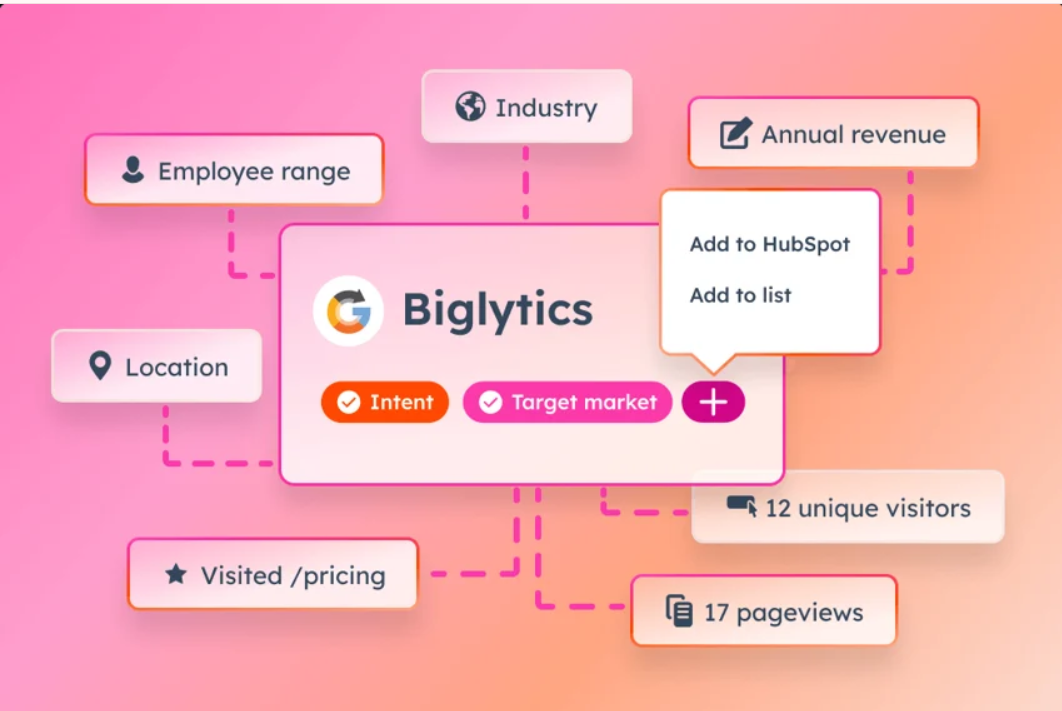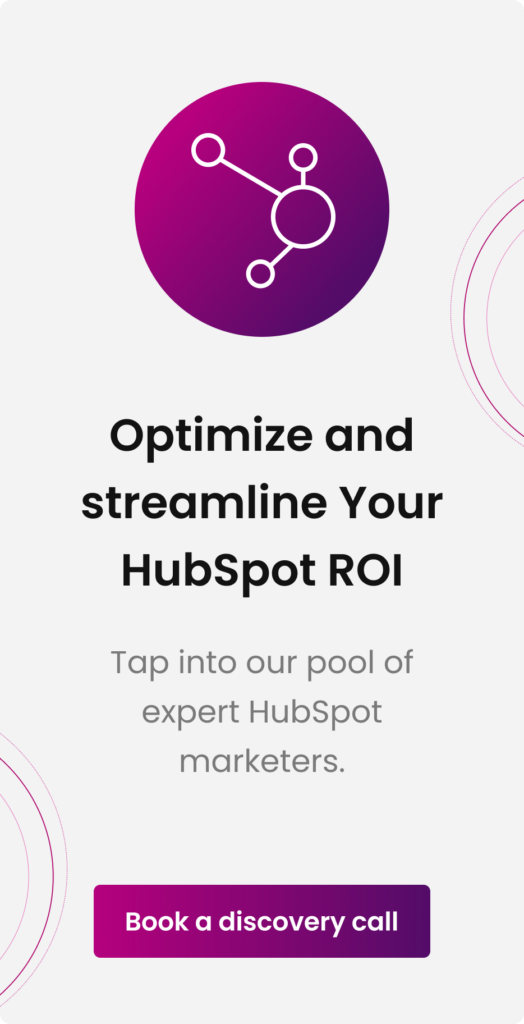HubSpot made waves at INBOUND 2024 with the launch of Breeze AI, an innovative AI solution set to transform how businesses grow and operate. Presented by HubSpot’s leaders, Yamini Rangan, Andy Pitre, and Dharmesh Shah, Breeze AI aims to accelerate business growth by harnessing the power of artificial intelligence.
With Breeze AI, even if your customer reaches out at 2 AM with a pressing question, they would receive instant, accurate support even while your team is away instead of waiting until morning.
What if this instant support doesn’t just solve a simple query but automatically connects the user to the right human agent if needed and delivers a full report with valuable insights afterward?
In this blog, I’ll guide you through the essential features of Breeze AI, including Breeze Intelligence, Copilot, and Agent AI, and how they work together to enhance your business operations. I’ll break down their components so you can quickly see how they fit into real-world business scenarios. My goal is to explain each feature clearly so you can understand how to make Breeze AI work for your team.
By bringing all its advanced AI tools under one roof, HubSpot has expanded its capabilities and reimagined the potential of AI for business. The AI tools you’re familiar with, like ChatSpot and generative AI, have now been supercharged to help you achieve more and faster.
What Is Breeze AI?
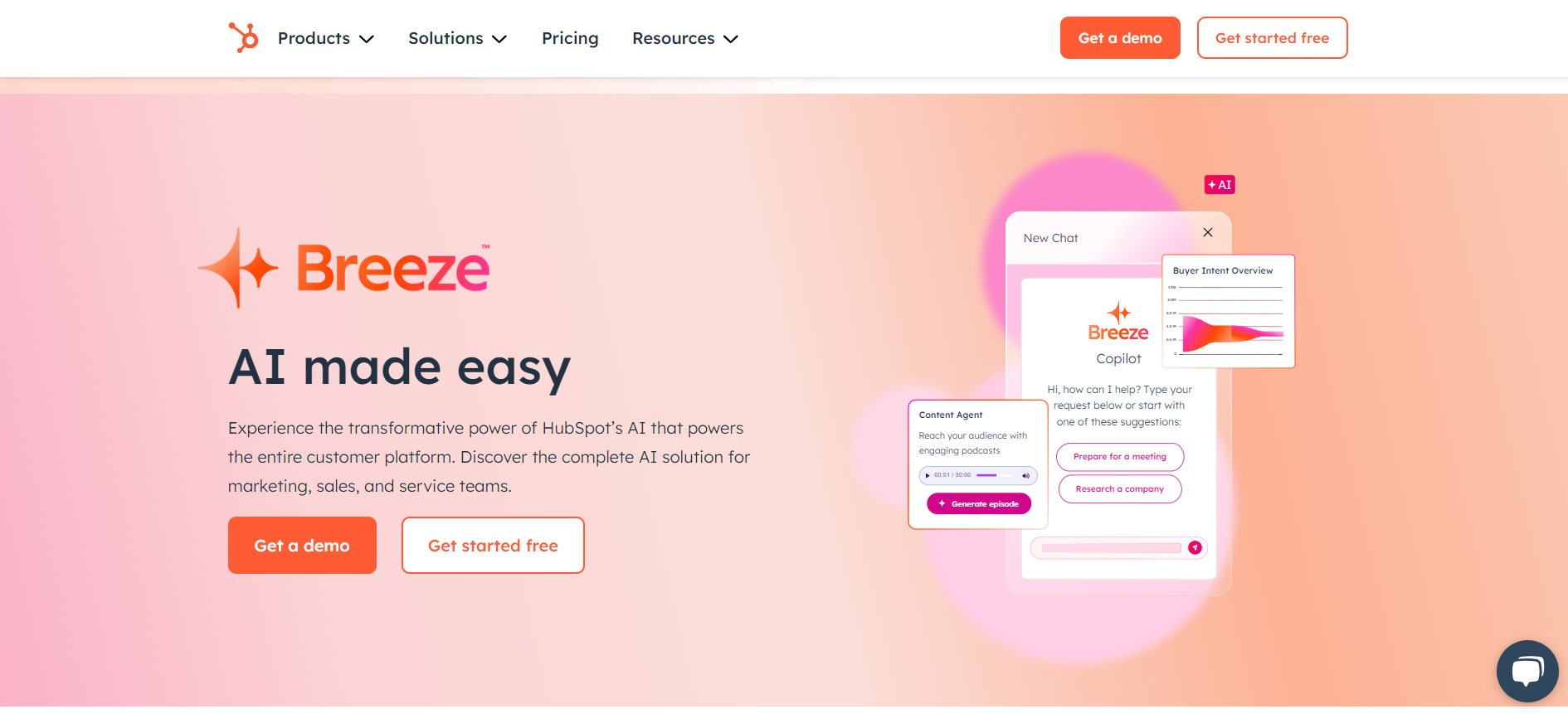
Businesses constantly juggle customer inquiries, manage leads, and try to stay ahead of their competition. The amount of data generated through customer interactions is massive, and organizing all of that effectively can feel like navigating through stormy waters.
Breeze AI would enhance your organization’s operations by automating crucial tasks such as customer service, content creation, lead generation, and data enrichment. This AI solution works tirelessly behind the scenes to ensure smooth and efficient operations, regardless of your business’s complexity or scale. It significantly lightens your team’s load by handling repetitive tasks, enabling quick, accurate, personalized customer interactions.
By integrating advanced AI with seamless CRM automation, Breeze AI saves time, reduces costs, and scales effectively to meet your needs. It optimizes key processes like handling customer inquiries and delivering data-driven sales follow-ups, ensuring your organization remains competitive in a market that demands immediate and personalized responses. This strategic automation lets your team focus on growth and innovation, improving workflow productivity and customer satisfaction.
How Does Breeze AI Work?
Breeze is powered by AI Agents, Copilot, and Intelligence. Here’s a practical breakdown of how Breeze functions:
- Customer Reaches Out: The AI-powered Breeze Customer Agent immediately engages, offering real-time answers based on pre-uploaded FAQs or CRM data.
- Handling Complex Queries: If the problem requires human intervention, Breeze AI routes the request to the appropriate customer support agent.
- Report Generation: After resolving the issue, Breeze AI generates a detailed report filled with insights on customer behavior, patterns, and areas for future improvements.
An Overview of Breeze AI’s Components
1. Breeze Copilot: Your All-in-One Assistant
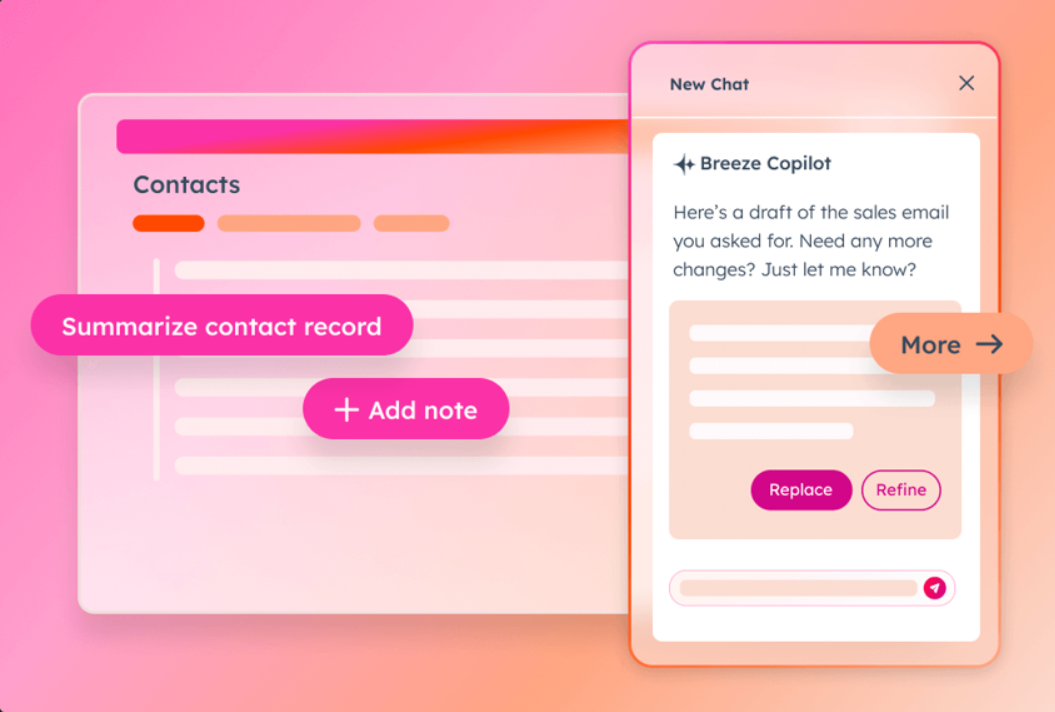
Breeze Copilot is like having a dedicated assistant who understands your business and can automate tasks with precision. Whether you need to draft a blog post, create a lead report, or analyze customer interactions, Breeze Copilot handles it.
Features
- Real-time Assistance: Copilot uses CRM data to suggest actions, helping teams stay proactive.
- Task Automation: Breeze Copilot simplifies day-to-day tasks from setting up marketing campaigns to organizing sales reports.
- Cross-platform Functionality: Available on desktop, browser, and mobile, ensuring teams can work on the go.
Suppose your marketing team must create a content calendar for the next quarter. Breeze Copilot can suggest content topics based on your CRM data, such as customers’ interests, past successful campaigns, and upcoming trends. It streamlines the process, saving hours of manual research and brainstorming.
How Does Breeze Copilot Streamline Daily Tasks?
Breeze Copilot enhances productivity by automating repetitive processes, saving time for teams to focus on higher-level strategy. Here is how it simplifies daily tasks:
- Automated Task Management: Copilot handles scheduling, email drafting, and follow-ups without human input.
- Data-Driven Decisions: It analyzes CRM data and suggests next actions, such as which leads to prioritize based on engagement.
- Content Creation: Helps draft blogs, emails, and reports using data from your CRM, ensuring relevance and accuracy.
Applying Breeze Copilot in Real Situations
Breeze Copilot can be applied across various industries to enhance efficiency and productivity:
- Sales Teams: Automatically schedules follow-ups with leads based on their engagement, allowing reps to focus on high-priority opportunities.
- Marketing Teams: Quickly drafts and personalizes email campaigns, saving time on content creation and ensuring messages align with customer data.
- Customer Service: Suggests responses to customer inquiries based on previous interactions, speeding up response times and improving service quality.
By automating routine tasks, Breeze Copilot lightens the team load, making daily operations smoother and more efficient. Its intelligent capabilities ensure that businesses maintain high productivity without needing constant manual input.
2. Breeze Agents: The Powerhouses of Automation
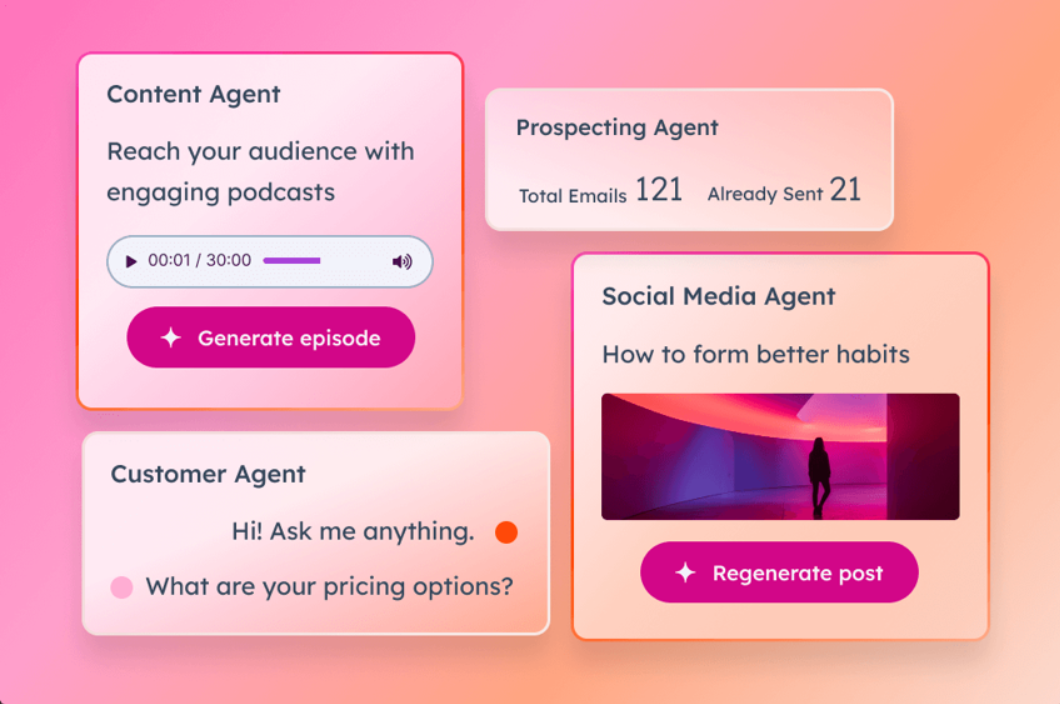
The heart of Breeze AI lies in its agents. These specialized AI tools handle the brunt of the work in various departments, starting from customer service to sales outreach.
How Breeze Agents Streamline Workflows?
Breeze Agents automate tasks in different areas of your business, helping to save time and reduce manual effort. There are four main types of Breeze Agents:
i. Content Agent: Automatically creates blogs, landing pages, case studies, and podcasts using CRM data.
Example: If you’re launching a new product, the Content Agent can generate an entire landing page, complete with images, SEO-optimized content, and lead capture forms.
ii. Customer Agent: As your AI-powered customer service representative, the Customer Agent handles real-time customer inquiries, answers questions, and routes more complex issues to human support agents.
Example: A customer asks about a delayed order. Breeze Customer Agent pulls information from the CRM, provides an update, and forwards the case to a human agent if a refund is needed.
iii. Prospecting Agent: Automates lead generation and personalized outreach by analyzing CRM data and behavior analytics.
Example: Your sales team receives automated, personalized email campaigns targeting warm leads, based on their website activity and past engagement with your brand.
iv. Social Media Agent: Creates and schedules social media posts, analyzes performance data, and suggests optimal posting times.
Example: Breeze Social Media Agent can automatically post updates and track engagement metrics across platforms like LinkedIn, Twitter, and Facebook.
Real-World Applications of Breeze Agents
Breeze Agents bring efficiency to various business processes:
- Content Creation: The Content Agent helps marketers quickly produce SEO-optimized content, reducing the workload on content teams.
- Sales Outreach: The Prospecting Agent automatically follows up with leads showing interest, ensuring timely responses that boost conversion rates.
- Customer Support: The Customer Agent manages basic inquiries, providing real-time responses to customers, which enhances the service experience.
- Social Media Management: The Social Media Agent keeps posts timely and consistent across platforms, ensuring maximum visibility.
3. Breeze Intelligence: Smart Data for Smarter Decisions
While Breeze Agents handle the front-end work, Breeze Intelligence works behind the scenes, enriching your CRM data with detailed insights from over 200 million buyer profiles. It tracks buyer intent, updates lead profiles in real time, and even automates form filling.
Features
- Data Enrichment: Breeze Intelligence automatically updates your CRM with new customer data, making sure profiles are always accurate.
- Buyer Intent: It can detect which leads are most likely to convert based on behavior data.
- Form Shortening: This AI tool reduces form friction by pre-filling known fields, improving conversion rates.
Example: If a lead has visited your website multiple times but hasn’t converted, Breeze Intelligence will automatically flag this lead as high intent and alert your sales team to prioritize outreach.
How Breeze Intelligence Enhances Data Management?
- Real-Time Data Enrichment: Automatically updates customer profiles with the latest information, ensuring accurate and up-to-date records.
- Buyer Intent Tracking: Identifies high-intent leads by analyzing customer interactions, such as website visits and content engagement.
- Form Shortening: Automatically fills in known information on forms, reducing friction for users and increasing form completion rates.
Breeze Intelligence in Action
Breeze Intelligence can significantly improve decision-making and efficiency across different business areas:
- Sales Teams: By tracking buyer intent, sales teams can prioritize leads most likely to convert, leading to more targeted outreach and better results.
- Marketing Teams: Automatically enriched data allows marketers to segment audiences more accurately, delivering personalized content that resonates.
- Customer Service: The real-time updates in customer profiles ensure that support teams have the most accurate information, leading to faster and more effective responses.
How Do Various Industries Benefit from Breeze AI?

As someone who has worked with various industries, I understand how essential it is to stay efficient and responsive in today’s fast-paced environment. Breeze AI is a powerful tool for automating tasks and enhancing customer engagement, allowing teams to focus more on growth, innovation, and customer satisfaction.
Here’s a look at the industries making the most of Breeze AI and how it’s enhancing their everyday operations:
1. E-Commerce
E-commerce businesses often deal with high volumes of customer inquiries, order tracking, and personalized marketing needs.
The Customer Agent provides 24/7 automated support, handling questions related to orders or product information. The Content Agent helps create product descriptions and promotional emails, while the Social Media Agent automates posts about sales and product launches.
Example: An online store uses Breeze to instantly respond to customer queries about product availability and shipping status. It also automates follow-up emails for abandoned carts, boosting conversions.
2. SaaS (Software as a Service)
SaaS companies must efficiently manage long sales cycles, customer onboarding, and technical support.
The Prospecting Agent nurtures leads by sending personalized follow-up emails after product demos or content downloads. The Customer Agent automates onboarding support, helping new users set up accounts without human intervention.
Example: A SaaS company leverages the Prospecting Agent to send personalized emails to leads who attended webinars, driving them further down the sales funnel.
3. Financial Services
The financial industry requires quick, accurate responses to inquiries about accounts, loans, and investments while maintaining data privacy.
The Customer Agent handles routine inquiries about account balances or loan applications, while Breeze Intelligence ensures customer profiles remain updated with real-time data enrichment.
Example: A bank uses Breeze to automate answers to frequently asked questions about loan rates, while the Prospecting Agent sends personalized emails to potential mortgage applicants.
4. Healthcare
Healthcare providers must efficiently manage patient inquiries, scheduling, and follow-up care while maintaining privacy and accuracy.
The Customer Agent automates responses to common inquiries like appointment scheduling and health service availability. Breeze Intelligence helps maintain accurate patient records, ensuring a personalized experience.
Example: A healthcare clinic uses Breeze AI to automate patient appointment scheduling and follow up with personalized care plans after consultations.
5. B2B Sales
Why it Benefits: B2B sales rely on long-term relationship building, requiring personalized communication and efficient lead management.
The Prospecting Agent automates personalized follow-ups with leads based on their interactions with marketing content. Breeze Intelligence tracks buyer intent, helping sales teams focus on the most engaged prospects.
Example: A B2B company uses Breeze to send personalized follow-ups after prospects attend a product demo, increasing engagement and accelerating the sales process.
6. Real Estate
Real estate agents manage multiple clients and property listings, requiring timely follow-ups and personalized service.
The Customer Agent answers inquiries about property listings, while the Prospecting Agent automates follow-ups with interested buyers, sending tailored messages about new listings.
Example: A real estate firm uses Breeze to automate follow-up emails for prospects interested in specific properties, increasing the likelihood of closing deals.
7. Retail
Retailers need to engage with customers both in-store and online while managing large volumes of data.
The Customer Agent provides instant answers to product-related questions, while Breeze Intelligence helps retailers track customer behavior and preferences, leading to personalized offers.
Example: A retailer uses Breeze to automate customer inquiries during peak shopping times, such as holiday sales, while offering personalized product recommendations based on browsing history.
8. Hospitality
Hotels, resorts, and travel agencies manage bookings and guest inquiries, often requiring 24/7 support and personalization.
The Customer Agent automates booking confirmations, inquiries about amenities, and cancellations, while the Social Media Agent promotes seasonal offers through timely posts.
Example: A hotel uses Breeze to handle booking confirmations and cancellations, reducing manual workload and ensuring timely responses for guests around the clock.
9. Education
Educational institutions need to manage inquiries from prospective students, parents, and current students, ensuring timely responses and personalized communication.
The Customer Agent answers questions about admissions, course offerings, and deadlines, while the Prospecting Agent follows up with prospective students based on their interests.
Example: An online learning platform uses Breeze to automate responses to inquiries about course enrollment and follow up with personalized recommendations for prospective students.
A Step-by-Step Guide to Using Breeze AI
Ready to get started with Breeze AI? Here’s a simplified breakdown of how to integrate Breeze into your existing workflow:
A. If You’re Using HubSpot CRM
Since Breeze AI is a part of HubSpot’s platform, the integration is seamless and requires minimal effort. Breeze AI is built directly into HubSpot, so there’s no need for complex setups or additional tools.
1. Sign Up for HubSpot
If you’re not already a HubSpot user, the first step is to sign up for an account. Breeze AI is fully integrated within HubSpot, so having access to the platform is essential.
You can choose from different HubSpot packages based on your business needs.
2. Enable Breeze AI Features
Once inside HubSpot, navigate to the Breeze AI section in your dashboard. You’ll be able to activate different Breeze AI tools, such as Breeze Copilot, Breeze Agents, and Breeze Intelligence.
You can customize which features you’d like to enable based on your business focus, such as customer service, marketing, or sales automation.
3. Sync Your CRM Data
Ensure that your CRM is up to date with accurate customer data. Breeze AI relies on this data to personalize tasks, whether automating sales follow-ups or creating content.
If you’re using a non-HubSpot CRM, integrate it through HubSpot’s API or marketplace apps.
4. Train Your Breeze AI Agents
Train Breeze Agents (such as Customer Agents, Content Agents, etc.) by providing them with necessary data like FAQs, customer information, and product details.
Set up workflows for each agent to automate tasks like customer support responses, lead generation follow-ups, or content creation.
5. Customize Automation Workflows
Define automation workflows based on your business needs. For example, a Customer Agent automates responses to frequently asked questions and routes more complex queries to human agents. Meanwhile, the Prospecting Agent will automate lead nurturing and follow-up emails based on engagement signals.
Use HubSpot’s workflow editor to easily set up this automation.
6. Integrate Breeze AI with Your Marketing Tools
Breeze AI integrates seamlessly with HubSpot’s marketing, sales, and service tools, so connect your email marketing, social media accounts, and ad platforms for better automation.
Automate tasks like sending personalized email campaigns or posting scheduled social media content.
7. Monitor Performance and Adjust Settings
Once Breeze AI is up and running, regularly check performance through HubSpot’s analytics. See how Breeze is handling tasks like customer service, lead conversions, or content automation.
Use this data to tweak settings and improve automation workflows for better efficiency.
8. Scale as Your Business Grows
Breeze AI will automatically adapt as your business scales to handle more customer inquiries, leads, and tasks. Keep adjusting your workflows and agents based on new business goals.
Consider upgrading your HubSpot plan for more advanced Breeze AI capabilities if you need additional features.
B. If You’re Using a Different CRM (Salesforce, Zoho, etc.)
HubSpot offers integrations with various third-party CRM platforms via their App Marketplace or API connections. While the integration may require more customization, the process remains user-friendly.
Steps for Integration:
1. Check for HubSpot Marketplace Integration:
Visit the HubSpot App Marketplace to see if your CRM has a pre-built integration with HubSpot.
Follow the instructions provided to connect the two platforms. This typically involves authorizing both systems to communicate and syncing data fields.
2. Use API for Custom Integration
If a direct integration is unavailable, HubSpot’s API tools allow you to create a custom connection between your existing CRM and Breeze AI.
Work with a developer or use HubSpot’s API documentation to connect customer data, ensuring that Breeze AI can access and update records in real time.
3. Map Data Fields
Ensure the data from your current CRM is properly mapped to HubSpot’s system. This includes customer records, interaction histories, and sales data.
Breeze AI will rely on this synced data to provide intelligent customer interactions and automate tasks.
4. Customize Workflows
Set up automation workflows that suit your business needs, like automatic lead nurturing, customer service automation, or sales outreach.
Breeze AI will now work alongside your existing CRM to automate these processes.
5. Monitor and Optimize
Once integrated, regularly check Breeze AI’s performance in handling tasks within your existing CRM. Adjust settings or workflows as necessary to fine-tune efficiency.
C. Integrating with Multiple Tools (for Advanced Users)
If your business uses multiple tools—such as a CRM, marketing platform, and customer service software—Breeze AI can still serve as the central hub by integrating these tools through HubSpot.
- Use Zapier: Tools like Zapier can help connect multiple apps and CRMs with HubSpot, allowing Breeze AI to pull data and automate tasks across different platforms.
- Set Up Custom APIs: If you’re working with custom tools, you can use HubSpot’s extensive API support to build a network of connected apps, allowing Breeze AI to access data from multiple sources.
Tips for Breeze AI Setup and Integration
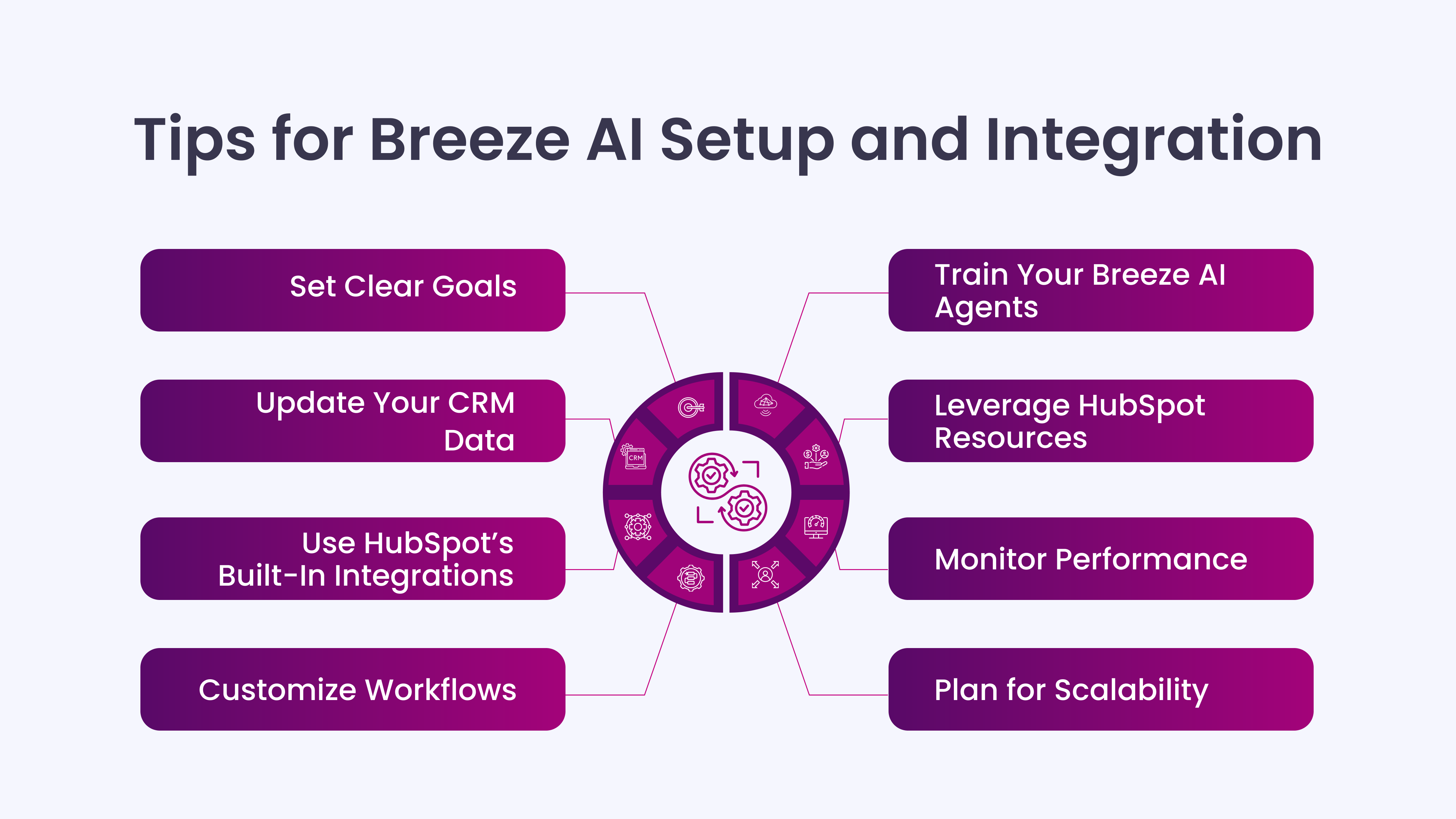
I’ve compiled important tips for efficient setup and integration to maximize Breeze AI’s potential. These will help you automate customer support, boost lead conversions, and streamline workflows from the start. Here’s how to get started!
- Set Clear Goals: Identify areas where Breeze AI can help (e.g., customer service or sales) and define measurable outcomes.
- Update Your CRM Data: Ensure all customer data is current and accurate for better automation.
- Use HubSpot’s Built-In Integrations: If you’re using HubSpot, Breeze AI integrates seamlessly. For other CRMs, check the App Marketplace or use APIs.
- Customize Workflows: Tailor automation workflows to your business needs and test them on a small scale before full deployment.
- Train Your Breeze AI Agents: Provide detailed FAQs and scenarios to ensure your agents handle tasks efficiently. Set up fallback options for human support.
- Monitor Performance: Regularly track Breeze AI’s performance with HubSpot analytics and adjust as needed.
- Plan for Scalability: As your business grows, update workflows and automation to meet new demands.
- Leverage HubSpot Resources: Use HubSpot’s tutorials, support, and webinars to get the most out of Breeze AI.
The Benefits of Breeze AI for Your Business
Drawing on my experience with various business tools, I’ve observed the transformative impact of the right AI. Breeze AI is one such tool that offers immediate, significant benefits to businesses.
- Boosts Efficiency: Automates tasks like customer support, follow-ups, and content creation, freeing up your team for more important work.
- 24/7 Support: Provides round-the-clock customer service, improving response times and customer satisfaction.
- Personalized Interactions: Uses real-time data to deliver tailored responses and messages, increasing engagement and conversions.
- Smarter Sales: Tracks buyer intent and automates lead nurturing, helping your sales team focus on high-value prospects.
- Real-Time Insights: Enriches your CRM with up-to-date customer data, giving you better decision-making power.
- Cost-Effective: Reduces the need for additional staff by automating repetitive tasks, saving on operational costs.
- Scalable: Grows with your business, handling more inquiries and data as your business expands.
- Effortless Integration: Easily integrates with HubSpot and other CRMs, ensuring smooth platform operations.
My Thoughts on Breeze AI and Its Role in the Future of CRM Automation
Breeze AI simplifies customer relationship management by automating critical tasks like customer support and lead follow-ups. This solution allows your team to concentrate on growing the business, whether you’re a small startup or a large enterprise. By offering personalized experiences and boosting efficiency, Breeze AI is more than just a tool—it’s a smarter, more intuitive way to operate your CRM, making workflows feel effortless while ensuring customers receive top-notch service.
As customer expectations evolve, the demand for quick, personalized service and meaningful interactions increases. Breeze AI meets these needs by blending advanced AI technology with a user-friendly interface, making it a pivotal solution for CRM automation. Its seamless integration with existing systems, scalability, and adaptability ensure your business stays competitive and prepares for future growth. With Breeze AI, you’re not just keeping up with the market but setting the pace for an automated, intelligent CRM future.
Transform Your CRM Strategy with INSIDEA’s HubSpot Services
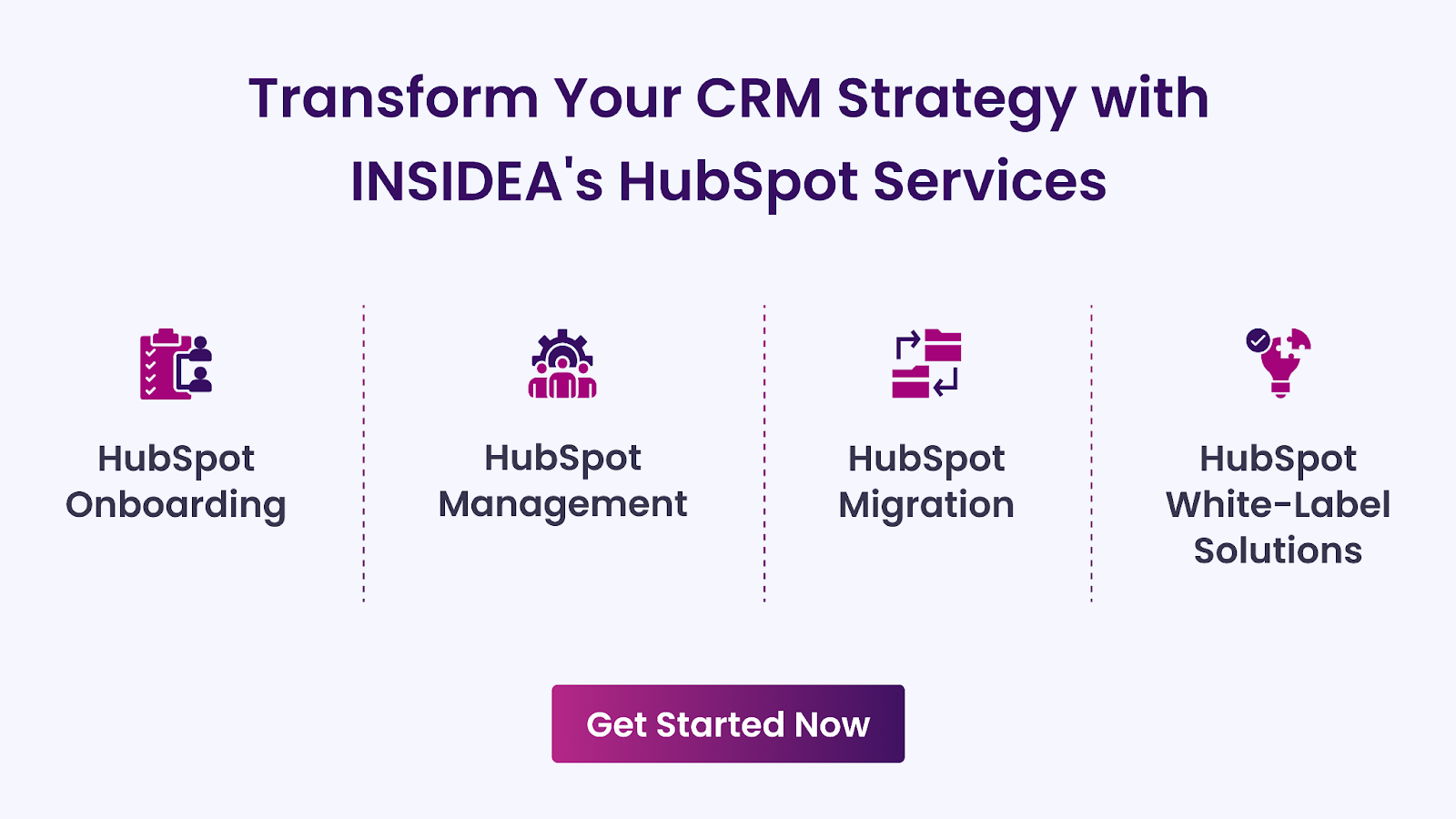
While automation is crucial for modern businesses, expert handling is required to leverage its benefits fully. As a HubSpot Diamond Solutions Partner, we take pride in assisting you in streamlining your HubSpot efforts. With our best-in-class marketing, sales, and service solutions, we help you scale exponentially. INSIDEA’s HubSpot Specialists have the required in-depth knowledge and can provide expert guidance on how to use the platform to meet your business needs.
Explore the range of services we offer:
- HubSpot Onboarding: Seamless onboarding process to get your team up to speed and fully integrated with all HubSpot features.
- HubSpot Management: Ongoing management ensures your HubSpot environment runs at peak efficiency.
- HubSpot Migration: Smooth and secure migration services that protect your data and enhance your CRM capabilities.
- HubSpot White-Label Solutions: Exclusive white-label services tailored to your brand, allowing you to offer branded HubSpot solutions.
Get in touch today to learn more about how INSIDEA can help you succeed!
At INSIDEA, we understand the importance of valuable HubSpot strategies that understand your target audience and drive conversions. Book a meeting with our HubSpot experts to explore how we can help you with your upcoming projects.
Get started now!





